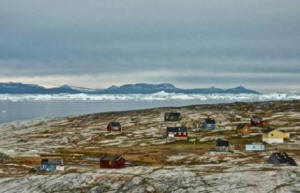|
 Arctic
advantage: genetic traits help Inuit in harsh conditions Arctic
advantage: genetic traits help Inuit in harsh conditions
 Send a link to a friend
Send a link to a friend
[September 21, 2015]
By Will Dunham
WASHINGTON (Reuters) - The Inuit, a group
of people who make the Arctic their home, have benefited from a handy
set of genetic adaptations that help them survive in some of Earth's
harshest conditions.
|
|
 Scientists on Thursday said a study of the genomes of Inuit from
Greenland revealed unique genetic variants related to fat metabolism
that ward off cardiovascular disease that otherwise could be caused
by a diet traditionally high in fat from blubbery seals and whales. Scientists on Thursday said a study of the genomes of Inuit from
Greenland revealed unique genetic variants related to fat metabolism
that ward off cardiovascular disease that otherwise could be caused
by a diet traditionally high in fat from blubbery seals and whales.
These genetic mutations, which the researchers said arose perhaps
20,000 years ago, help lower "bad" LDL cholesterol and fasting
insulin levels, limit the height of the Inuit, keep down their
weight and help them adapt to a cold environment.
"Our study is perhaps the most extreme example to date of a genetic
adaptation to a specific diet," said computational biology professor
Rasmus Nielsen of the University of California, Berkeley and the
University of Copenhagen.
"The mutations we find seem to compensate physiologically for a
large intake of animal fat and are largely an adaptation to a
lifestyle in which you have a high-caloric intake of fat from marine
mammals, and possibly also from other mammals."
 The Inuit, formerly called Eskimos, are indigenous people in
Greenland and Arctic regions of Canada and Alaska.
The researchers examined genomes of 191 Inuit, 60 Europeans and 44
Han Chinese. The genetic variants found almost universally in the
Inuit were much rarer in the Europeans (2 percent) and Chinese (15
percent).
The research, published in the journal Science, is the latest to
illustrate human genetic adaptation to environmental conditions.
[to top of second column] |

"One of the best examples is the Tibetans' adaptation to high
altitude," said University of Copenhagen computational biology
professor Anders Albrechtsen, referring to a study showing that many
Tibetans possess a rare variant of a gene involved in carrying
oxygen in the blood, helping them in high-altitude, low-oxygen
conditions.
The Inuit findings may shed light on the value of diet
supplementation with omega-3 fatty acids and fish oils. Nielsen
noted such supplementation was originally motivated by observations
that Inuit people had a high intake of fat but low cardiovascular
disease incidence, so the particular form of fat they got in their
diet might be healthier than other kinds.
"Our study shows that lessons from the Inuit cannot be extrapolated
to other populations. The Inuit have special genetic variants that
might allow them to function better on a diet rich in omega-3s than
other populations," Nielsen said.
(Reporting by Will Dunham; Editing by Eric Walsh)
[© 2015 Thomson Reuters. All rights
reserved.]
Copyright 2015 Reuters. All rights reserved. This material may not be published,
broadcast, rewritten or redistributed. |